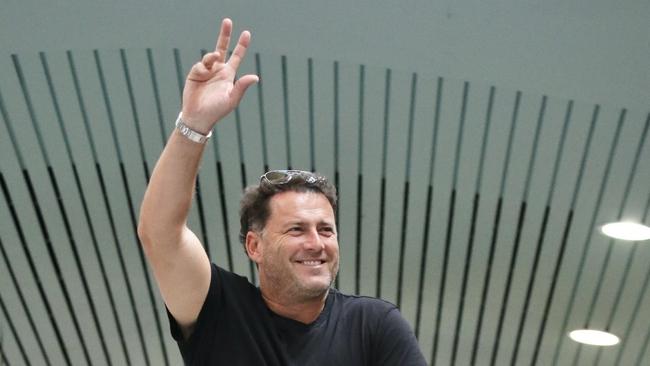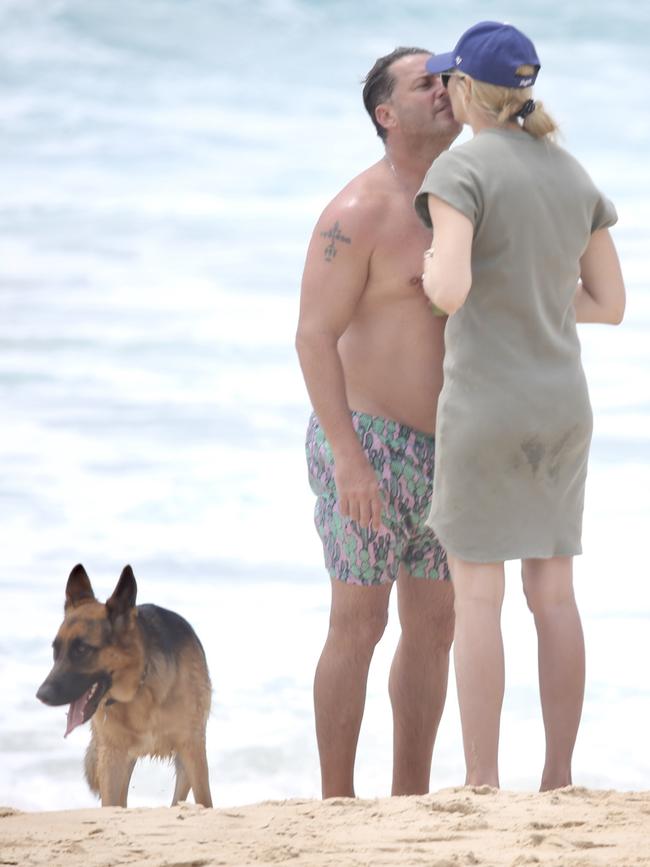Revived Karl Stefanovic back in hot seat but Nine’s TV star factory fades
Karl Stefanovic’s return to the poorly rating Today show comes as Nine battles to weave together its jostling cultures.

It is late November and the television ratings year is still rattling to a close as Karl Stefanovic unfurls himself in his Qantas business-class recliner and eases into the long flight to Los Angeles.
Nine’s impetuous television star has been given the all-clear for a secret interview with a celebrity mate and can finally breathe a sigh of relief: he is back in the good books at Nine.
Ashen-faced Nine executives have just confirmed they were wrong to sack Stefanovic — condemning him to a tumultuous 12 months in off-air limbo — and are spruiking his much-vaunted return to its beleaguered breakfast show across the front pages of the company’s Sydney tabloid newspaper.
The 45-year-old’s star is on the rise again, and his masters are even letting him jet to the US to shoot a 60 Minutes puff piece on Sydney shock jock Kyle Sandilands — a close friend who publicly stood by him after he was axed from Today in December 2018 — to run later this year.
Stefanovic’s return to the poorly rating Today show comes as one of Australia’s biggest media companies battles to weave together the jostling cultures of its television network, Sydney and Melbourne newspapers once owned by Fairfax and combative talkback radio stations.
The handling of Stefanovic’s brutal sacking while he was on his honeymoon with new wife Jasmine Yarbrough and his subsequent resurrection have not sat well with everyone.
Former Nine chief David Leckie, who ran the network from 1994 to 2001 when it ruled the airwaves, says he is appalled by the company’s callous treatment of Stefanovic, and its “tacky” page-one cross-promotional treatment in Nine’s Sydney Morning Herald, which relegated coverage of the state’s bushfire crisis to inside the paper.
Leckie questions Nine’s promise that the pages of the Fairfax metropolitan mastheads would remain sacrosanct and “independent, always” when it acquired the newspapers in 2018.
“(Current Nine chief executive) Hugh Marks is a good friend of mine, and he’s a shrewd operator … but it’s completely amateurish, some of the things they are doing as a company right now,” Leckie says.
“I have never seen a show f..ked up the way the Today show has been — whoever has been overseeing those decisions should not be working in television.
“What’s worse, you’ve got those people who can’t even manage a TV station now intruding and trying to dictate what appears in the company’s newspapers. I am lost for words.”
Nine is now so keen to get Stefanovic back on air that it has brought forward his debut twice. It first moved his scheduled return ahead a week to Monday. Then on Friday, the network announced he would jump into the hot seat from 7am on Saturday for a special bushfires edition.

Seven’s arch rival, Sunrise, matched the first timetable shuffle, recalling hosts Sam Armytage and David Koch from holidays a week early to face off against Stefanovic and his new co-host, Allison Langdon, but is persevering with its regular weekend line-up until then.
According to Nine insiders, Stefanovic is so relieved with his resurgence that he does not nurse a grudge over his demise a year ago. “His relief (at being reinstated on Today) has been palpable — he was genuinely starting to fret about his future,” says one senior Nine staff member close to the Stefanovic camp.
“The fact he got to fly over to LA and interview Kyle, and repay him for all his support throughout the year, was a massive bonus … when you’re in TV and you’re not on TV, you can’t help but worry. The longer that goes on, the more the public starts to forget about you, and Nine has a long history of ‘warehousing’ out-of-favour talent and killing their careers.”
Stefanovic has been so on-edge about his return that he fired off a legal letter to Sydney’s Sunday Telegraph, owned by News Corp Australia, which publishes this newspaper, threatening to sue over its coverage of his comeback without even telling his boss.
The challenge caught Marks off-guard and the legal action has now been quietly withdrawn from court.
In the end, though, Stefanovic need not have worried about being forgotten. If nothing else, the past year has proven he remains a figure of enduring national fascination, whether he is on the box or not.
Former Studio 10 executive producer Rob McKnight says that even off-air, Stefanovic remains Nine’s brightest star and biggest drawcard, much to the chagrin of the faceless executives who knifed him. “Once upon a time, there was one person who was seen as the face of a network backed up by a galaxy of stars,” he says.
“Those days are long gone and the hosts of breakfast TV now fill the void. Karl Stefanovic had more coverage than any other personality on Nine in 2019 and he was barely seen on-air.”
It is that fascination those same executives are now banking on to draw a crowd. Publicly, Nine has been giving the impression it has offered him a second chance — but, internally, it is being treated more like a second coming.
The network is at pains to ensure Stefanovic feels welcome, particularly given that his painful departure sparked a Today show purge that eventually counted his younger brother Peter and sister-in-law Sylvia Jeffreys among its casualties.
The program’s young staff, which endured a massive turnover while he has been away, are dutifully praying for him to work miracles and save the crippled show.
Others are not so enamoured by the so-called “Karl Factor”. Former Today executive producer Steve Wood, who ran the show in its glory years, from 1991 to 2002, predicts that the new line-up — the third in little more than a year — is doomed to fail.
“Karl is a great performer but he has blotted his copybook and it’s going to be difficult for him to recover,’’ Wood says. “His larrikinism makes him watchable but it’s also what gets him into trouble.
“Now Nine are hoping that the very man they got rid of because he wasn’t working will be the very man that can win back viewers. That doesn’t make much sense.
“Seven are the juggernauts — David Koch is someone who everyone relates to: he’s smart and funny and seen as a family man.
“Karl is divorced and remarried — and not the guy people used to like any more. That’s life, people change, but he’s no longer the family-friendly guy that the show needs.”
Wood also has grave reservations about the content of the program that Stefanovic will be leading. “I have been told they’re going to try being more ‘hard news’ — well, ‘news of the day’ — and make that their focus,” he says. “But ultimately the accountants are running the place now so ‘news of the day’ means reporters sitting around discussing what’s in the papers – it will be like (US chat show) The View except stretched out over 3½ hours.
“The big names used to be enough to engage audiences but they’re not even looking after them either.
“The Nine star factory was started under (former chief executive) Sam Chisholm, and David Leckie kept driving that when he took over — but they don’t seem to care about that any more; and if they don’t care about their big stars, why should the audience?”
Leckie could not agree more, and says that “star power” is now more crucial than ever as streaming services continue to cut large swaths through traditional audience numbers.
“All free-to-air television has left is news, sport and current affairs — and the stars that run a few programs,” he says.
“That’s all they have to work with — but I can’t see Nine getting it together and beating Sunrise.
“All Nine care about nowadays is cutting costs.”
Just this week, the company’s radio arm, Macquarie Media, which operates 2GB in Sydney, 3AW in Melbourne and 4BC in Brisbane, rebranded its bulletins as Nine News updates.
The bulletins are now produced in tandem with the network’s television newsrooms, and all across Nine’s media entities, buzzwords such as “synergy” reign supreme.
“The way the network is being run now, the heads of every arm are being played off against each other and they’re all jockeying for favour,” another senior Nine executive reveals.
“There’s a meeting each week where they run through the numbers and note, ‘Nine shows got seven mentions in the SMH on such and such a day, that’s good’, with absolutely no care as to how that is affecting the way the paper’s editorial independence is seen by its readers, or if the mentions are even connecting with the right audience.”
In the newspaper division, reporters are now encouraged to collaborate with Nine’s 60 Minutes and A Current Affair, rather than the ABC’s Four Corners and 7.30; some say the subtle intrusion is also being noticed in print.
“It’s been a slippery slope,” one Nine newspaper journalist complains. “These tiny, little, incremental changes start coming in and then next thing you know, we’ve got an ad for the Today show disguised as a news story running on our front page.
“The same thing is happening in the sports section, where the tennis coverage is being trumped up because Nine owns the television broadcast rights, and we’re even seeing the Channel 9 logo plugging its coverage creeping into the middle of our stories.”
Media Alliance media president and former Herald science editor Marcus Strom says Nine metropolitan newspapers are covered by a strict charter of independence that ensures Nine’s board and management play absolutely no part in editorial decision-making.
“Everyone I speak to says they are relieved and glad that Nine has recognised the values of having a diversity of editorial cultures,” Strom says. “There’s a recognition that they have separate audiences as well.”
He also points out that the newspapers’ editorial staff condemned Marks’s ill-advised decision to host a $10,000-a-head Liberal Party fundraiser attended by Scott Morrison on the set of the Today show last September, saying that the event left reporters demanding to know “where Nine newspapers’ political loyalties lie” in a letter to the Nine boss.
“If you buy titles that go back 150-plus years that have a reputation for independence, I think you have to adapt your corporate culture to that and I think Nine realised that and realised that was a mistake to have that fundraiser,” Strom says.
Nine’s publicity department agrees, insisting there are no issues with the editorial independence or integrity of any of its editorial products, across television, radio and newspapers.
James Chessell, the group executive director of Nine’s newspapers, defends the decision to run the Stefanovic story on The Sydney Morning Herald’s front page, adding: “It’s probably a waste of time pointing out (The Australian) ran a Today story on its front page that same week.”
One thing is clear, Wood says: Nine has now backed itself into a corner as far as the Today show and Stefanovic are concerned.
After constantly meddling with the format and presenters, it is too risky to blow it up yet again, even if the broadcaster’s comeback fails to resonate with viewers.
“They’re going to have to stick with him whether they want to or not, otherwise they’re going to look like they’re chasing their arses and Today may as well pack up and become children’s TV — it’s that dire,” he warns.
Doing so will give Stefanovic the upper hand when it comes to renegotiating his contract at the end of the year.
Additional reporting: Adeshola Ore, David Ross



To join the conversation, please log in. Don't have an account? Register
Join the conversation, you are commenting as Logout